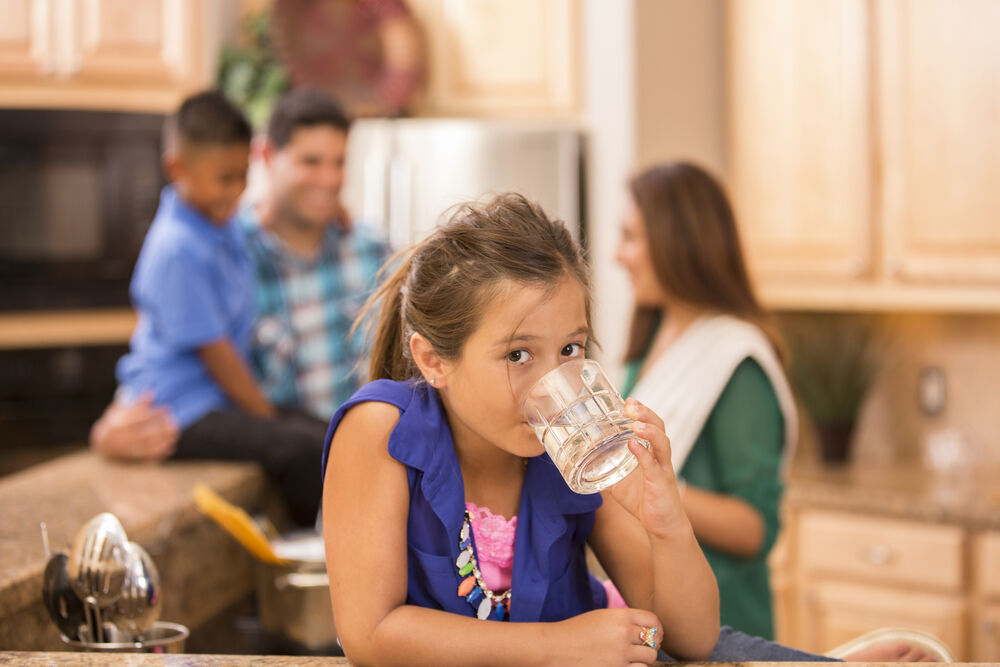The increasing rates of childhood obesity are alarming. Studies have shown that what children drink can play an important role in maintaining children’s health and, ultimately, children’s weight (Cleveland Clinic, 2019). The American Academy of Pediatrics (AAP), warns that excessive daily sugar intake may lead to obesity and type 2 diabetes. Therefore, the AAP recommends aiming for less than 25 grams (about 6 teaspoons) of added sugar per day for children 2 years of age and older.
Many parents and caregivers offer children fruit juices and fruit drinks and may think they are giving their children needed vitamins or nutrients, but this may not always be the case. Nutrition facts can be found on the back of the juice packaging (e.g., bottle, box), and parents/caregivers should look carefully at the ingredients and at the amount of sugar per serving in the drink.
Here’s a closer look at how much sugar is in popular children’s drinks. Each teaspoon of sugar is equal to 4 grams (remember, aim for less than 25 grams of added sugar per day) (Penn State Extension, n.d.):
| Drink | Serving Size | Amount of sugar |
|---|---|---|
| Soda | 8-ounce cup | 26 grams (less than 1 can) = 6.5 tsp. |
| Fruit punch juice drink | 8-ounce cup | 30 grams = 7.5 tsp. |
| Fruit punch cocktail | 8-ounce cup | 34 grams = 8.5 tsp. |
| 100% juice (no sugar added) | 8-ounce cup | 26 grams = 6.5 tsp. |
Best practices for beverage consumption according to the AAP (2017) are as follows:
- Water: Available from household water faucets or in bottles or cans, and often a child can access water independently
- Fruit juice: Offer only products that are 100% juice; limit to no more than 4-6 ounces per day per child and
encourage parents to support this limit (keep juice from getting on the loose!) - Sugary drinks: Never offer these drinks (includes fruit drinks, sports drinks, sweet tea, and soda)
- Milk: Serve only 1% or non-fat (skim) milk to children 2 years and older (unless otherwise directed by the child’s health provider)
According to the AAP (2017), even 100% fruit juice, while there is no added sugar, is simply sugar from the whole fruit, and the juice lacks the fiber and some nutrients that are found in the whole fruit. Research suggests that drinking juice may lead children to develop a taste for sweet things, which could be detrimental to children’s overall and continued health. In addition, the AAP recommends that fruit juice not be given to infants under 12 months of age since it offers no nutritional benefit to babies in this age group. After 12 months of age, infants may have limited amounts (see recommendations below) of 100% fruit juice daily (APA, 2017). Remember, just because a drink claims to be 100% fruit juice doesn’t mean it’s a healthy option for children (Eichberger, 2018).
Key tips regarding fruit juice follow:
- Fruit juice offers no nutritional benefits over whole fruit. Whole fruits also provide fiberand other nutrients. Infants should not be given fruit juice at bedtime or as a treatment of dehydration or management of diarrhea.
- For children ages 1 to 3 years old:Limit fruit juice consumption to no more than 4 ounces each day.
- For children ages 4 to 6 years of age:Limit fruit juice consumption to 4 to 6 ounces each day.
Additional resources:
Clearinghouse for Military Family Readiness at Penn State. (2017, July 11). 5210 Make your own sugar bottle display. https://5210.psu.edu/toolkits/
Penn State Extension. (n.d.). The best drinks for kids. Better Kid Care. https://extension.psu.edu/programs/betterkidcare/early-care/tip-pages/all/the-best-drinks-for-children
References:
American Academy of Pediatrics. (2017). Fruit juice and your child’s diet. Healthy Children. https://www.healthychildren.org/English/healthy-living/nutrition/Pages/Fruit-Juice-and-Your-Childs-Diet.aspx
American Academy of Pediatrics. (2017). Where we stand: fruit juice. Healthy Children. https://www.healthychildren.org/English/healthy-living/nutrition/Pages/Where-We-Stand-Fruit-Juice.aspx
Cleveland Clinic. (2019). Parents: Regular milk and water is best for kids. Health Essentials. https://health.clevelandclinic.org/parents-regular-milk-and-water-is-best-for-kids/
Eichberger, S. (2018, August 27). Is fruit juice healthy for kids? Michigan State University Extension Food and Health. https://www.canr.msu.edu/news/is-fruit-juice-healthy-for-kids
Penn State Extension. (n.d). The best drinks for kids. Better Kid Care. https://extension.psu.edu/programs/betterkidcare/early-care/tip-pages/all/the-best-drinks-for-children





